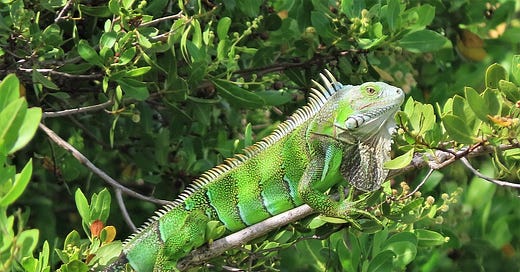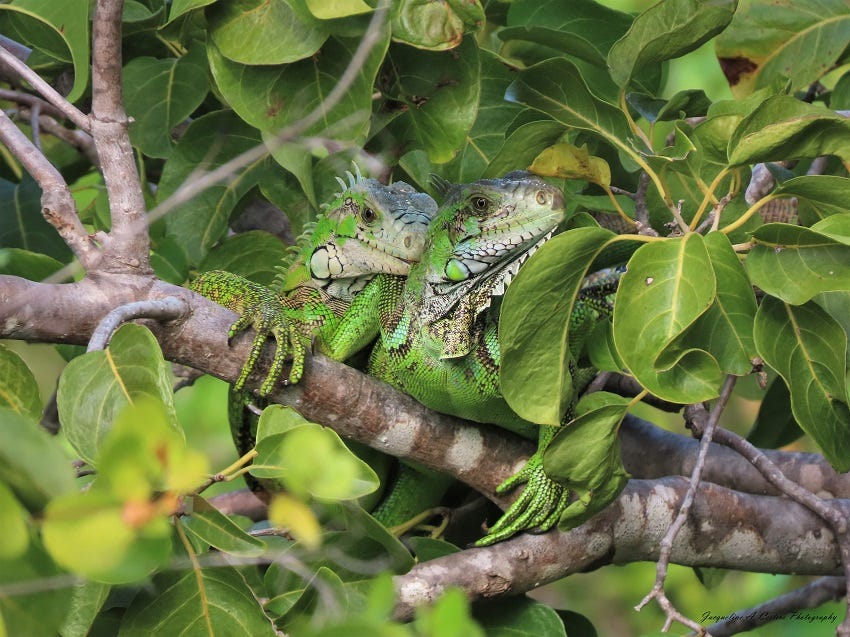The Pesky Green Iguana
You either love them or hate them! There seems to be no middle-of-the-road when it comes to the Green Iguana.
The history of the Green Iguana in Anguilla is relatively short. According to the literature, in the aftermath of Hurricane Luis in 1995, a few individuals floated into Anguilla on logs. Anguillans recall a large number of them at Windward Point after the storm. It appears that there is a disconnect between the two accounts.
The increasing population has adversely impacted the resident Lesser Antillean Iguana. Some of the remaining native iguanas have been relocated to Prickly Pear East to help restore the population. It is too early to tell if that program has been a success.
My tour guests often marvel at these dinosaur-like creatures, prompting an explanation of their impact on the local environment.
The native range for Green Iguanas is from southern Mexico to central Brazil. In the Caribbean and the United States, they are an introduced species. In the USA, particularly in Florida, they were often purchased as pets. Once they were too difficult to care for, they were set free.
Green Iguanas come in a variety of colors. The dark tail rings and Subtympanic Shield (Green Iguana Anatomy) are a quick way to distinguish them from other species.
Males can grow up to 5 feet in length and weigh as much as 17 pounds. Females also can grow to 5 feet but only weigh 7 pounds. Their life span ranges from 8 to 20 years.
Female Green Iguanas reach sexual maturity at 2 to 4 years of age. Both males and females take on multiple partners.
During the dry season, the female digs a series of interconnected tunnels extending up to 80 feet and lays clutches of 14 to 76 eggs. The female defends the tunnel only while laying the eggs and then allows nature to take its course.
After 10 to 15 weeks, the hatchlings emerge and fend for themselves, although they may stay in familial groups for up to a year. They are bright green and resemble females. Their diet consists of vegetation, insects, and snails.
Adults are naturally herbivorous reptiles but are known to eat bird eggs, dead animals, grasshoppers, and tree snails.
In Anguilla, they are particularly fond of fruit trees like Papaya. This destructive behavior has made them public enemy number one with local farmers.
“They are excellent swimmers, tolerating both salt and fresh water, and can submerge themselves for up to four hours at a time.”
Green Iguanas use their tail to propel themselves through the water, allowing their legs to fall to the side.
Green Iguanas prefer living near water. On Anguilla, salt ponds or rocky coastlines are the best places to see them. A quick scan of the mangrove on many wetlands will net a good look at an iguana.
The Aurora Golf Course is another favored location, and you will often see them sunning on the greens.
These prehistoric-looking reptiles are pretty much a community nightmare. They eat everything, produce too many offspring, and impact other species.
Even though they are IUCN-listed as a species of Least Concern, they have their struggles.
“Historically, Green iguana meat and eggs have been eaten as a source of protein throughout their native range, and are prized for their alleged medicinal and aphrodisiac properties. Hides of these lizards are also used producing leather. Green iguanas also suffer greatly from the international pet trade and the loss of their native habitat due to development and land conversion for grazing.”
Because they are considered an invasive species in the United States, it is legal to hunt them as long as you don’t violate any humane treatment laws.
On the bright side, their ability to disperse seeds is beneficial in the Caribbean, where islands are subject to more intense storms due to climate change.
I find myself conflicted regarding their presence here in Anguilla. No humane management plan currently exists to control our widespread and growing population.
Over the years, they have delighted my guests and provided an excellent opportunity to discuss invasive species in island nations.
I enjoy a small family group on my property. They give me countless hours of fun and photographic opportunities throughout the year. I think it’s worth losing a few Pawpaw from the garden for that experience.
Have you seen Green Iguanas while visiting Anguilla? Please share your story in the comments.











